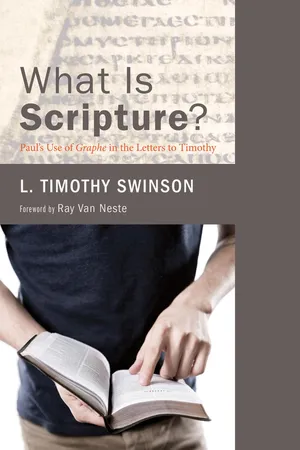![]()
Chapter 1
What Is γραφη? Thesis and Introduction
With regard to Paul’s letters to Timothy, analysis of exegetical and historical data suggests that γραφή, as it is employed in each letter, legitimately should be understood not as a reference limited strictly to the Law, Prophets, and Writings, but as a term that includes at least some of the apostolic writings that now appear in the NT. Specifically, this study argues that a written version of the Gospel of Luke stands as the source of the second referent of ἡ γραφή in 1 Tim 5:18, while it also argues that πᾶσα γραφή in 2 Tim 3:16 includes as its referent the apostolic writings extant in Paul’s day, most especially Luke’s gospel and Paul’s own letters. The findings of these parallel lines of analysis will indicate that Paul, the writer of record, ascribes to his own teaching and to that of his apostolic coworkers an authoritative standing equal to that attributed to the sacred writings (τὰ ἱερὰ γράμματα) found in the OT.
In 1 Tim 5:18, the second of two quotations appears to offer a citation of Luke 10:7 as Scripture, though many dispute such an assessment, typically accounting for the apparent correlation with Luke by positing a Logion source. In 2 Tim 3:16–17, Paul comments directly upon the merits of “all Scripture.” A significant minority of interpreters maintains that in this second passage, Paul views the apostolic writings of his day, including his own writings, as Scripture alongside the OT writings. However, the majority opinion insists that whoever the writer may be, he would refer only to the OT writings as “Scripture.” The question regarding the referents of these occurrences of γραφή, along with the possibility raised by some interpreters that they designate writings of both the OT and NT as “Scripture,” knits these two texts together in this study, the significance of which emerges against the backdrop of the scenario outlined below.
Skepticism Regarding the Canon
Over the past two centuries, Christianity’s high view of Scripture, along with the very notion of a NT canon or a true Christian orthodoxy, has endured persistent opposition from those skeptical of the Bible’s divine origins and normative function. Increasingly, the legitimacy of a list of “inspired” NT books is dismissed. What premises and observations typically lay behind such disbelief, and are there data that might challenge them? In order to assess these questions, it may prove constructive first to consider briefly the positions of three representatives of this canonical skepticism: namely, James Barr, Lee McDonald, and Bart Ehrman.
In 1983, James Barr offered the observation that there exists “no scriptural evidence to decide what were the exact limits of the canon.” Essentially, Barr argued that if Scripture were the final authority and arbiter of theological truth, then we would expect to find an explicit assertion of such authority within the scope of Scripture itself. Since we do not, according to Barr, whatever authority we may ascribe to Scripture must derive from outside the Bible, he external sanction of which functions as the real or practical authority over theology and doctrine. Accordingly, Barr maintained,
Consequently, according to Barr, the entire Protestant edifice rests ultimately not upon biblical authority, but upon a self-authenticating Protestant tradition regarding biblical authority, thereby rendering the principles of biblical authority and sola scriptura meaningless (a fair inference, if his premise is correct).
In a parallel analysis, Lee McDonald seems to suggest that the relative scarcity of explicit first-century data attesting to a broad recognition of the apostolic writings as Scripture necessarily implies the absence of such recognition. He further supports his position against an early sense of the New Testament as Scripture by pleading that the New Testament writers had few scruples about altering OT teaching. Indeed, he writes,
With respect to the apostolic writings, McDonald adds,
McDonald’s point, assuming that Jesus viewed his own teaching as superseding that of Moses, and that Paul also considered the Law, Prophets, and Writings as temporary, lies in highlighting the implication that the very idea of “Scripture” as a fixed and authoritative point of reference did not exist either for Jesus...
